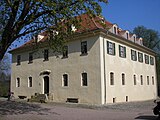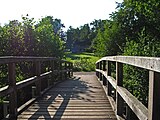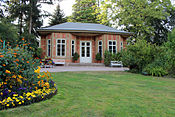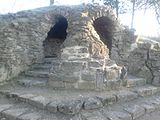Tiefurt Castle

Tiefurt Castle is a small country castle on the Ilm in the Tiefurt district of the city of Weimar , about four kilometers east of the city center. The palace was the summer residence of Duchess Anna Amalia of Saxe-Weimar-Eisenach . Along with the castle park Tiefurt heard it since 1998 as part of the ensemble " Classical Weimar " for UNESCO - World Heritage Site .
history
lock
The castle was originally the tenant house of a ducal chamber estate . The building, built at the end of the 16th century and remodeled and expanded in 1765, consists of a main building, the upper floor of which comprises seven rooms, and a smaller outbuilding. Both are connected by a covered walkway. On the upper floor there is a terrace with a pergola on which a girl's sculpture , the ankle player created by Martin Gottlieb Klauer around 1790, and two sphinxes can be seen.
In 1776, Duke Carl August's younger brother Konstantin set up his own court in the palace under the guidance of his tutor Karl Ludwig von Knebel . Four years later, during a lengthy absence of the prince, his mother Anna Amalia chose the castle as a summer residence. She moved into the upper floor with two servants; Her court lady Luise von Göchhausen was housed in the adjoining building. The Göchhausen's room has the following peculiarity: Since she was crooked, she could only look at normally aligned pictures slightly distorted. The pictures in her room are therefore painted and framed in such a way that the views take your state of mind into account. Two statues should be referred to separately here. On the one hand it is a cast of the “Freezing” by Houdon from the Louvre from 1793 and on the other hand that of the Melpomene in the fireplace room. Tiefurt became the meeting point of the Weimar Musenhof . But there were also numerous other guests here, such as the Humboldt brothers and the painter Charles Gore . It is also noteworthy that this group published a journal by Tiefurt . This journal, initially only published in a few individual handwritten copies, was first distributed in a larger edition in 1892 by Bernhard Suphan and Eduard von der Hellen on behalf of the Goethe Society Weimar. In 2011 the Goethe-Gesellschaft Weimar published a new edition of the journal.
After the Duchess's death in 1807, the building was neglected and also plundered by the French occupiers in 1806, but Grand Duke Carl Friedrich , Carl August's son , initiated the renovation while Goethe was still alive. The well-known landscape gardener Eduard Petzold was appointed to maintain the park . It is also noteworthy that the Goethesche Urfaust was found in a secretary by the court lady Anna Amalias Luise von Göchhausen and was copied. While Goethe's original manuscript was destroyed by the poet himself, Göchhausen's copy was preserved and eventually went to print. Under Clemens Wenzeslaus Coudray , the castle was rebuilt in 1821–1828 and was given its current shape. There are two drawings of Tiefurt Castle. One is from 1793 by Conrad Westermayr in the Goethe National Museum in Weimar with the inv. No.KHz1983 / 00421 . Another ink drawing by Carl Wilhelm Holdermann has come down to us in an etching by Carl Hummel from 1840. A copy of this can be found in the Leipzig City History Museum , for example .
A look into the kitchen reveals not only the accessories, including wood and pewter, but also imitation roasts and paper mache dishes .
In 1907 the castle was turned into a museum and opened to visitors. A comprehensive renovation in the style of the 1800s took place from 1978 to 1981. The sequence of rooms from the time of Anna Amalia was restored on the upper floor.
Castle Park
On the adjacent meadow area with a size of about 21 hectares, bordered by an Ilm loop, work began on creating an English-style landscape park , which was already open to the public at that time. The park covers both sides of the Ilm. Two bridges crossing the river created the connection: the Sheep Bridge and the Yellow Bridge, which leads to the tea house . The highest point in the castle park is the Vergilgrotte . The upper path on the outer side of the Ilm leads from the Vergilgrotte to a stone with a verse, a distich , which is ascribed to either Goethe or Knebel. The castle became Anna Amalia's favorite residence for about 25 years and a center of the Weimar poets' circle. The Duchess had the portraits of Christoph Martin Wieland , Johann Gottfried Herder and of course Goethe put up in the park. These were made of wood. Only one stone portrait of Wieland is still in the park in the Wieland corner, which was made by Johann Gottfried Schadow (1802). There is also the Herder memorial stone. The center of the park is the temple of the Muses in the shape of a monopteros with the elaborate borders with which it is surrounded. In addition to the already mentioned tea house, the Mozart monument Tiefurt , which is located in the immediate vicinity, is one of the striking park architectures . Not far from the castle in the entrance area is a stone with a verse by Friedrich von Matthissons from the poem Vauklüse from 1792.
The park also served as a backdrop for Anna Amalia's amateur theater . The singspiel Die Fischerin , composed by Goethe's poem on July 22, 1782 , was premiered here. According to Goethe, the piece was completely related to the forest and water nature of the place and was primarily aimed at lighting effects. Corona Schröter played the main role here . The stage technology for this was made by Johann Martin Mieding . In honor of Corona Schröter, whom he held in high esteem, Goethe had a monument erected in Tiefurt in the form of the stone image Amor as a nightingale feeder . This was created by Martin Gottlieb Klauer in 1796 . There are also tombs for the brother of Anna Amalia Prince Leopold von Braunschweig , who died fighting a flood disaster in Frankfurt (Oder) in 1785, and for her son Konstantin , who fell ill in Pirmasens in 1793 and died as a Prussian major general in Wiebelskirchen . Klauer created the monument to Leopold von Braunschweig in 1785 based on a design by Adam Friedrich Oeser . In general, Oeser was significantly involved in the garden design concept for the park.
Not far from the palace is a sundial , which was made by court sculptor Martin Gottlieb Klauer in 1798.
Hanns Moritz von Brühl and Christina von Brühl from Seifersdorf near Dresden were close to Duchess Anna Amalia . Hanns Moritz was the youngest son of Heinrich Graf von Brühl , the electoral Saxon and royal Polish prime minister. Christina von Brühl laid out the Seifersdorfer Valley as one of the first landscape gardens from 1781 . Similar monuments were erected there as in Tiefurt. There you can find a memorial to Duchess Anna Amalia and her brother Leopold von Braunschweig-Wolfenbüttel . There is also a monument to Johann Gottfried Herder . A Goethe monument erected in the garden by the manor house no longer exists today. Carl von Brühl Tina's son, like his parents, stayed in Weimar from time to time and liked to visit the Duchess.
The park itself is connected to the grounds of Kromsdorf Castle and the Park on the Ilm by the Ilm and the paths that lead past it. The Ilm flows between Tiefurt and Weimar below the Webichtes .
Even if it is located outside, the effect of the view of the village church of St. Christophorus von Tiefurt has been included in the park design at least since Eduard Petzold . This is only a short distance from the castle. After all, it was a place where Johann Sebastian Bach worked . Goethe and Franz Liszt were also often here because of the organ. In the years 1846 to 1850, the castle park Tiefurt was redesigned by Petzold according to the plans of his teacher Hermann Fürst von Pückler-Muskau .
- Architecture and art in the Tiefurt Castle Park
The Weimar Musenhof : Friedrich Schiller reads in Tiefurt Park; Wieland (seated in the middle) and Goethe (standing on the right)are among the audience. Oil painting by Theobald von Oer (1807–1885), 1860.
Today's view of the Temple of the Muses, built in 1803, with a Kalliope sculpture in the center, often wrongly referred to as Polyhymnia , as well as elaborate ornamental plants around the park architecture.
On the "Yellow Bridge" over the Ilm with a view towards the tea house of the 21 hectare castle park Tiefurt.
Mozart monument Tiefurt as a copper engraving in the Journal of Luxury and Fashion 1799
Wieland bust by Schadow in the castle grounds in Tiefurt
Herder monument in the castle park
literature
- Gerhard R. Kaiser: Tiefurt: Literature and life at the beginning of Weimar's great time , Wallstein-Verlag Göttingen 2020. ISBN 9783835336599
- Hans Wahl : Tiefurt. J. J. Weber, Leipzig 1929 (new edition 1936: Weberschiffchen-Bücherei 19).
- Friedrich Menzel: Tiefurt Castle. National research u. Memorials of Classical German Literature, Weimar 1978.
- Rebecca Elisabeth Meyer: Castle Park in Tiefurt near Weimar. 2010. [2]
- Wolfgang Horn: Tiefurt miniatures. Forays through a garden monument of the Weimar Classic. Jena 2001, ISBN 3-931743-46-2 .
- Julius Hartwig: Draft for the layout of a promenade from Weimar to Tiefurt, Oberweimar, Ehringsdorf, Belvedere . Weimar 1856 ( digitized version from HAAB Weimar ).
- Oskar Hensoldt: Plan of the Grand Ducal Park in Tiefurt . Weimar 1844 ( digitized version from HAAB Weimar ).
Web links
- Tiefurt Castle on the website of the Weimar Classic Foundation
- http://www.klassik-stiftung.de/uploads/tx_lombkswmargcontent/tiefurt_mit_Bildern_01.pdf
- http://www.goethezeitportal.de/fileadmin/PDF/db/wiss/epoche/mommsen_journal-von-tiefurth.pdf
Individual evidence
- ↑ http://www.ife.uzh.ch/research/emeriti/oelkersjuergen/alteskripte/010_GesamtSS05.pdf
- ↑ Joseph Rückert: Comments on Weimar 1799 , Weimar 1969, pp. 41 and 202.
- ↑ "It started as a weekly joke": the journal of Tiefurt / ed. by Jutta Heinz and Jochen Golz . Among employees by Cornelia Ilbrig ..., Göttingen 2011, p. 13.
- ↑ https://www.tagungshotel.com/hotel_1373463889.htm In addition to the former tenant house, the Alte Remise , now a restaurant, and an event barn of a conference hotel, which is now also used as an event location, are the most striking parts of the former chamber property.
- ↑ Eduard von der Hellen (ed.): Das Journal von Tiefurt , in: Schriften der Goethe-Gesellschaft, ed. by Bernhard Suphan, Volume 7, Weimar 1892. Digitized
- ↑ "It started as a weekly joke": the journal of Tiefurt. Edited by Jutta Heinz and Jochen Golz , with co-workers. by Cornelia Ilbrig ..., Göttingen 2011, ISBN 978-3-8353-0957-9 .
- ↑ http://www.goethezeitportal.de/fileadmin/PDF/db/wiss/epoche/mommsen_journal-von-tiefurth.pdf p. 19.
- ↑ with the inventory number: S / 264/2006 . S. [1]
-
↑
- [,] STEEP HEIGHTS BEAUTIFUL
- THE SERIOUS INQUIRING WISDOM
- GENTLE PATH
- LOVE WALKS IN THE THAL '
- ↑ https://de.wikisource.org/wiki/Vaukl%C3%BCse
- ↑ http://www.literaturland-thueringen.de/artikel/ein-literarischer-spaziergang-durch-den-tiefurter-park/stein-mit-inschrift-von-friedrich-von-matthisson/
-
↑
- HERE LIVES THE SILENCE OF THE HEART, GOLDEN PICTURES
- RISE FROM THE WATERS OF CLEAR SKY
- AUDIBLE AT THE SOURCE THE QUIET FIT
- BLESSING SPIRITS
- FRIEDR. v. MATTHISON
- ↑ A watercolor by Georg Melchior Kraus shows a scene from the world premiere in Tiefurt.
- ↑ Timo John: Adam Friedrich Oeser 1717-1799: Study on an Artist of Sensibility , Beucha 2001, p. 154 f. ISBN 978-3-934544-17-8
- ^ Gitta Günther , Wolfram Huschke , Walter Steiner (eds.): Weimar. Lexicon on city history. Hermann Böhlaus successor, Weimar 1998, p. 403.
- ↑ Description and directory of the TOREVTICA-WAARE of the Klauersche Art Factory in Weimar , ed. by Martin Gottlieb Klauer. With copper. (Zweyter booklet), Weimar 1800, plate XV No. 104. (Kalliope) and No. 111 (Polyhymnia).
Coordinates: 50 ° 59 ′ 38 ″ N , 11 ° 21 ′ 49 ″ E




















